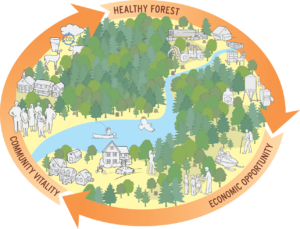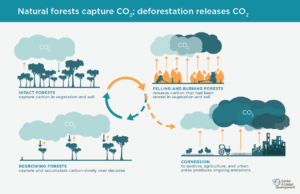
Forests are more than just a collection of trees; they are a vital part of our planet’s ecosystem and economy. They provide a myriad of benefits that extend beyond their intrinsic beauty, playing a crucial role in sustainable growth and economic stability. This article explores the economic impact of forest conservation and why protecting forests is essential for sustainable development.
Understanding Forests and Their Economic Value
Forests cover about 31% of the Earth’s land area, making them a significant component of our natural resources. They are home to over 80% of the world’s terrestrial biodiversity and offer numerous ecosystem services that contribute to the economy. These services include carbon sequestration, water regulation, soil fertility maintenance, and the provision of raw materials.
- Carbon Sequestration and Climate Regulation
Forests act as carbon sinks, absorbing large amounts of carbon dioxide (CO2) from the atmosphere. This process helps mitigate climate change by reducing greenhouse gas concentrations. The economic value of this service is substantial. According to a study published in Nature Climate Change, global forest carbon sequestration is valued at approximately $300 billion annually. By protecting forests, we ensure that this carbon sequestration process continues, thus preventing the economic costs associated with climate change, such as increased extreme weather events and damage to infrastructure.
- Water Regulation and Soil Protection
Forests play a crucial role in regulating water cycles. They enhance groundwater recharge, reduce the risk of floods, and help maintain water quality by filtering pollutants. The economic benefits of these functions are significant. For instance, the protection of watersheds through forest conservation can lead to lower water treatment costs. According to the International Union for Conservation of Nature (IUCN), investing in forest conservation to safeguard water resources can save up to $10 billion annually in water treatment expenses.
Forests also prevent soil erosion by stabilizing the soil with their root systems. This not only protects agricultural land but also reduces the costs associated with soil degradation and land rehabilitation. The United Nations Environment Programme (UNEP) estimates that soil erosion costs developing countries around $40 billion annually. Forest conservation helps mitigate these costs by maintaining soil health and productivity.
- Biodiversity and Ecotourism
Forests are home to a rich variety of plant and animal species, many of which are unique to specific forest ecosystems. Biodiversity contributes to the resilience of ecosystems, which in turn supports agricultural productivity and disease regulation. The economic value of biodiversity is reflected in sectors such as pharmaceuticals, agriculture, and tourism.
Ecotourism, in particular, leverages the beauty and diversity of forests to generate revenue. Countries with well-preserved forests attract tourists seeking natural experiences, which boosts local economies. According to the World Travel & Tourism Council (WTTC), ecotourism generates billions of dollars annually and provides employment opportunities in rural areas. For example, Costa Rica’s investment in forest conservation has turned it into a leading ecotourism destination, significantly contributing to its national economy.
- Sustainable Timber and Non-Timber Products

Forests provide a range of products beyond timber, including medicinal plants, fruits, nuts, and resins. The sustainable management of forest resources ensures a continuous supply of these products while preserving the forest ecosystem. The global market for sustainable timber and non-timber forest products is growing, driven by increasing consumer demand for eco-friendly products.
Sustainable forest management practices, such as selective logging and agroforestry, create economic opportunities for local communities. The Food and Agriculture Organization (FAO) reports that sustainable forestry can contribute up to $600 billion annually to the global economy. By protecting forests and promoting sustainable practices, we support livelihoods and contribute to economic growth.
- Job Creation and Rural Development
Forest conservation and sustainable management create jobs and promote rural development. Activities such as forest monitoring, eco-tourism, and sustainable harvesting require a skilled workforce, providing employment opportunities in rural areas. The World Bank highlights that forest-related industries can create millions of jobs globally, contributing to poverty alleviation and economic stability.
In addition to direct employment, forest conservation can stimulate local economies by supporting small businesses and infrastructure development. For example, forest-based enterprises can include craft production, herbal medicine, and environmental education services. These activities enhance local economic resilience and promote sustainable livelihoods.
Challenges and Solutions
Despite the economic benefits of forest conservation, challenges remain. Deforestation, illegal logging, and land conversion for agriculture threaten forest ecosystems worldwide. To address these challenges, it is crucial to implement effective policies and practices that balance economic development with environmental protection.
- Strengthening Policies and Governance
Governments play a critical role in forest conservation by enacting and enforcing laws that protect forests and promote sustainable management. Effective governance ensures that forest resources are used responsibly and that conservation efforts are supported. Policies such as protected areas, forest certification, and incentives for sustainable practices can help achieve these goals.
- Promoting Public Awareness and Education
Public awareness and education are essential for garnering support for forest conservation. By educating communities about the economic and environmental benefits of forests, we can foster a culture of conservation. Initiatives such as community-based forest management and participatory conservation programs empower local stakeholders and encourage sustainable practices.
- Encouraging Private Sector Involvement

The private sector has a crucial role to play in forest conservation. Companies can adopt sustainable supply chain practices, invest in reforestation projects, and support conservation initiatives. Corporate social responsibility (CSR) programs that focus on environmental sustainability can enhance a company’s reputation and contribute to long-term economic growth.
Conclusion
Forest conservation is not just an environmental issue; it is a fundamental component of sustainable economic growth. The economic benefits of protecting forests are vast, encompassing carbon sequestration, water regulation, soil protection, biodiversity, ecotourism, and sustainable resource use. By investing in forest conservation, we safeguard these benefits and contribute to a more sustainable and resilient economy.


